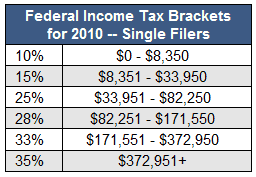Calculating Taxes
Syllabus: Calculate the marginal rate of tax and the average rate of tax from a set of data.Marginal Rate of tax

Here you can see the income tax thresholds for the USA Federal Income Tax. It is progressive as the higher the income received the higher the tax rate. The most significant thing to take note of is that each bracket only refers to income earned at that level. A person receiving $10,351 would have $8,351 taxed at the rate of 10% and the next $2,000 taxed at 15% - they would NOT have the whole 10,351 taxed at 15%.
The marginal tax rate is the tax rate on the next $ received. If a person was receiving $35,000 and they were to receive an extra $1 the marginal tax rate would be 25%.
If a person was receiving $8,350 and gained an extra $1 then the marginal tax rate for that $ would be 15% - they would pay an extra 15c in tax.
More Detail if you need it
This table can be a little confusing without further explanation. Please note that everyone is taxed in steps. A person earning $100,000 is not taxed 28% on the entire amount. Instead, he is taxed 10% on the first $8,350 earned, 15% for the portion $8,351to $33,950, 25% for $33,951 to $82,250, and 28% for the remainder:

Average Rate of tax
The Average Rate of Tax is calculated by ATR = Total Tax Paid
Total Taxable Income
The total amount of taxes paid by an individual or business divided by taxable income. This rate will vary based on the amount of income received during the taxable period. For example, if Steve paid $3,000 in taxes on income of $25,000, his average tax rate would be 12%. Formula: Paid taxes/taxable income = average tax rate.
Read more: http://www.investorwords.com/8529/average_tax_rate.html#ixzz3x2jzdi9I
Note: If people are allowed to earn a basic amount which is not subject to tax it should not be included in the calculation.
Past Paper Essay
Nov 2008
3. (a) Explain the difference between progressive taxation and regressive taxation. [10 marks]
(b) Evaluate the possible effects of a decrease in direct taxation on a country’s inflation rate, unemployment rate and balance of payments. [15 marks]